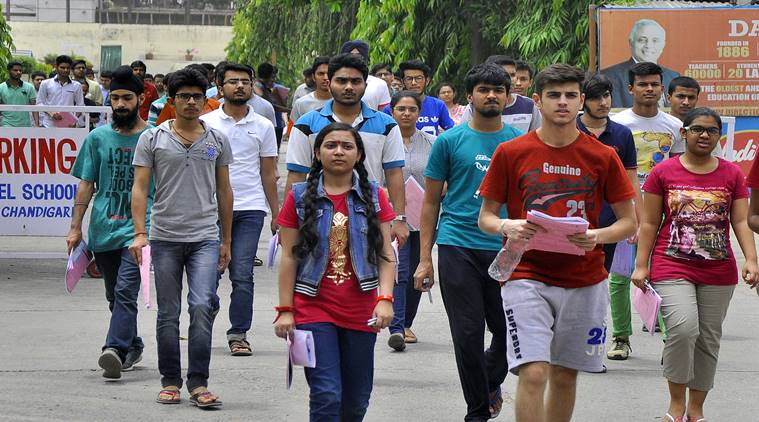 IIM CAT 2020 will be held on November 29. Representational image/ file
IIM CAT 2020 will be held on November 29. Representational image/ file
IIM CAT 2020: The Comom Admission Test (CAT 2020) will be held on November 29, 2020. This year, the entrance exam will be conducted by Indian Institute of Indore. The online registration for CAT will start from August 5 to September 16, 2020.
CAT will be conducted in test centres spread across around 156 test cities. Candidates will be given the option to select any four test cities in order of their preference. Those who clear the exam will be eligible for admission to management courses, including PGP, PGDM, PGPEM, EPGP, PGPBM, PGPEX, at various IIMs and other B-schools across the country.
The candidates must possess Bachelor’s degree with at least 50 per cent marks or equivalent. The reserve category candidates — Scheduled Caste (SC), Scheduled Tribe (ST) and Persons with Disability (PwD) — need to hold a minimum of 45 per cent marks from the recognised university.
The application fees for the candidates belong to the general category is Rs ₹2000, while for the reserved category SC, ST and PwD are Rs 1000.
Exam pattern
The examination will be of 180 minutes and candidates will be allotted sixty minutes for answering questions in each section and they will be restricted to switch from one section to another. The questions will be in three sections, A. Verbal Ability and Reading Comprehension, B. Data Interpretation and Logical Reasoning, C. Quantitative Ability.
Syllabus
Verbal ability and reading comprehension
Grammar, Verbal Reasoning, Syllogisms, Sentence completion, Fill in the blanks, Jumbled paragraphs, Para Completion and inference, Foreign language words used in English, Contextual usage, Reading Comprehension, Sentence correction, Analogies, Different usage of same word, Idioms, Verbal Logic, Antonyms, One word substitution, Parajumbles
Logical Reasoning and Data Interpretation
Blood Relations, Coding-Decoding, Proposition, Series, Direction Sense, Assumptions, Clocks and Calendars, Statements, Puzzles, Family Tree, Data Arrangement, Binary Logic, Venn Diagram, Syllogism, Sets, Data Structures, Seating Arrangement
Data interpretation
Tables, Casslets, Data Sufficiency, Line Graphs, Pie Charts, Bars
Quantitative Aptitude
Geometry, HCF and LCM, Trigonometry, Algebra, Averages, Partnership (Accounts), Profit & Loss, Time Speed and Distance, Mensuration, Surds and Indices, Quadratic and linear equations, Ratios and Proportion, Percentages, Surds and Indices, Geometric Progression, Inequalities, Number system, Work and time, Logarithms
Reservation
Around 15 per cent seats are reserved for Scheduled Caste (SC), 7.5 per cent for the Scheduled Tribe (ST) candidates.
27 per cent of the seats is reserved for other backward class (OBC) candidates and 10 per cent seats for the Economically Weaker Sections (EWS) candidates.
Normalisation process
How to calculate scores
Calculation of scaled score of a candidate:
Following steps are followed to calculate the scaled score of a candidate in each of the three
sections, i.e. VARC, DILR and QA in CAT 2020. The overall scaled score is obtained by
adding scaled scores of these three sections. While illustrating the scaling process, QA section
is chosen as an example. Similar process is valid for the other two sections, i.e. DILR and
VARC.
Step 1: Calculate the mean and the standard deviation (SD) of the raw scores in QA section for
all candidates appearing in the morning session.
Let Mean = M1 and SD = S1 and G1 = M1 + S1.
Step 2: Calculate the mean and the standard deviation (SD) of the raw scores in QA section for
all candidates appearing in the afternoon session.
Let Mean = M2 and SD = S2 and G2 = M2 + S2.
Step 3: Calculate the mean and the standard deviation (SD) of the raw scores in QA section for
all candidates appearing in CAT (i.e. including both morning and afternoon sessions).
Let Mean = M and SD = S and G = M + S.
Step 4: Calculate the mean raw score in QA section of the top 0.1% candidates in the morning
session and denote it by 𝑀𝑀1
0.1.
Step 5: Calculate the mean raw score in QA of top 0.1% candidates in the afternoon session
and denote it by 𝑀𝑀2
0.1.
Step 6: Calculate the mean raw score in QA of top 0.1% candidates appearing in CAT (i.e.
considering both morning and afternoon session) and denote it by 𝑀𝑀0.1.
Suppose now XYZ is a candidate who appeared in the morning session and her raw score in
QA section is R. Then the scaled score of XYZ in QA, say 𝑅𝑅� given by:
𝑅𝑅� = (𝑅𝑅 − 𝐺𝐺1) 𝑀𝑀0.1−𝐺𝐺
𝑀𝑀1
0.1−𝐺𝐺1
+ 𝐺𝐺.
In case XYZ is a candidate who appeared in the afternoon session and her raw score in QA
section is R. Then the scaled score of XYZ in QA, say 𝑅𝑅� is given by:
𝑅𝑅� = (𝑅𝑅 − 𝐺𝐺2) 𝑀𝑀0.1−𝐺𝐺
𝑀𝑀2
0.1−𝐺𝐺2
+ 𝐺𝐺.
Similar methodology is applied for the computation of scaled scores for other sections.
If this formula yields any scaled score as more than 100, it will be rounded down to 100.
The Common Admission Test (CAT 2020) is conducted by the IIMs to fill seats in their PGP programmes. The entrance exam’s scores are accepted by many B-schools including JNU.